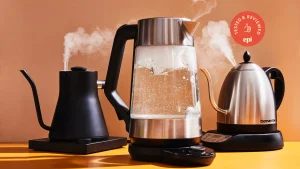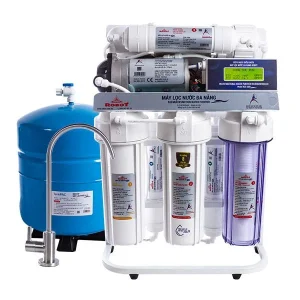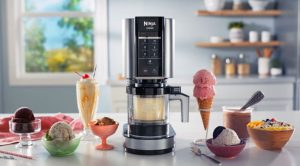Blender: What Is It? How It Works, Applications, and Safe Usage Tips

A blender is a versatile kitchen appliance designed to mix, puree, crush, and blend food and liquids. With its ability to turn whole fruits, vegetables, and other ingredients into smooth mixtures, blenders are an essential tool for preparing everything from smoothies and soups to sauces and cocktails. In this article, we’ll explore what a blender is, how it works, its practical applications, and provide safe usage tips to help you get the most out of this handy appliance.
1. What Is a Blender?
A blender is an electric kitchen appliance that combines and blends ingredients together, transforming them into a smooth, consistent mixture. Whether you’re making a smoothie, pureeing soup, or preparing a sauce, a blender can be your go-to tool for quickly processing food.
Common Types of Blenders:
- Countertop Blenders: These are the most common type of blenders and are designed for general kitchen use. They come in various sizes and power capacities and are great for making smoothies, purees, soups, and more. They feature a motorized base and a jar with sharp blades that rotate at high speeds.
- Immersion Blenders (Hand Blenders): Unlike countertop blenders, immersion blenders are handheld devices that allow you to blend ingredients directly in a container. They are especially useful for smaller tasks, such as blending soups in a pot or making small batches of sauces or smoothies.
- Personal Blenders: Personal blenders are compact and designed for making single servings of smoothies or shakes. These blenders typically have a smaller base and container, making them perfect for individuals or small households.
- Commercial Blenders: These high-powered blenders are designed for heavy-duty use in restaurants, cafes, and smoothie bars. They are built to handle large quantities of ingredients and have stronger motors for quicker, more efficient blending.
Benefits of Using a Blender:
- Convenience: Blenders make meal preparation quick and easy, allowing you to create a variety of recipes in a fraction of the time.
- Versatility: With the ability to blend, puree, chop, crush, and emulsify, blenders are versatile tools that can be used for a wide range of kitchen tasks.
- Healthy Eating: Blenders allow you to make healthy smoothies, soups, and other meals that retain most of the nutrients from whole ingredients, such as fruits and vegetables.
2. How Does a Blender Work?
Blenders operate by using a motor to rotate blades at high speeds, which breaks down food and liquids into smaller, uniform pieces. The specific mechanics depend on the type of blender, but the basic process remains the same.
Key Components of a Blender:
- Motor Base: The motor base powers the blender, allowing the blades to rotate. The motor is the heart of the blender, and its power determines how well the blender can handle different ingredients.
- Blades: Blades are typically made of stainless steel and are sharp enough to chop, crush, and blend ingredients. Most blenders have multiple blades that work together to achieve a smooth and consistent blend.
- Jar (Container): The jar holds the ingredients that need to be blended. It is usually made of glass, plastic, or stainless steel and may come with measurement markings on the side for convenience.
- Control Settings: Blenders often feature a control panel with buttons or dials that allow you to adjust speed settings and select preset functions such as pulse, ice crush, or smoothie mode.
The Blending Process:
- Adding Ingredients: Place the ingredients into the blender jar, making sure to follow the recipe instructions for proper ingredient proportions.
- Securing the Lid: Once the ingredients are in, secure the lid tightly to prevent spillage during blending.
- Blending: Turn on the blender, adjusting the speed and settings as needed. The blades will rotate at high speeds to blend, chop, and mix the ingredients into a smooth consistency.
- Stopping the Blender: Once the desired texture is achieved, turn off the blender. Carefully remove the jar from the base and pour the blended mixture into a serving dish or container.
3. Where Is a Blender Used?
Blenders are used in various contexts, from home kitchens to commercial establishments. They serve as essential tools in many applications:
Home Use:
- Smoothies and Shakes: Blenders are commonly used to make fruit and vegetable smoothies, protein shakes, and other health-conscious beverages.
- Soups and Purees: Blenders can turn raw or cooked vegetables into smooth purees or soups, making them ideal for preparing homemade soups, baby food, and sauces.
- Batters and Doughs: Some blenders can be used to mix batters for pancakes, waffles, or cakes. They can also be used for grinding nuts or making dough for recipes like pizza crust or bread.
- Cocktails and Beverages: Blenders are often used to prepare cocktails, frozen drinks, and slushes. The high-speed blending capability makes it easy to mix ice and liquids into refreshing beverages.
Commercial Use:
- Restaurants and Cafes: Blenders are a staple in commercial kitchens, where they are used for preparing smoothies, sauces, soups, and other menu items. They help speed up food preparation and ensure consistency in texture and flavor.
- Juice Bars and Smoothie Bars: Blenders are essential tools in juice bars and smoothie bars, where they are used to prepare a wide range of fruit and vegetable blends.
- Bakeries and Food Manufacturers: In commercial bakeries or food production facilities, large industrial blenders are used for mixing ingredients in bulk, such as dough or fillings.
Health and Wellness:
- Nutritional Supplements: Blenders are often used by individuals who are health-conscious and want to create homemade nutritional shakes or supplements tailored to their needs.
4. How to Use a Blender Safely
Using a blender is straightforward, but following safety guidelines is crucial to avoid accidents and ensure optimal performance.
Before Using the Blender:
- Check the Blade Assembly: Ensure that the blades are securely attached and positioned correctly before operating the blender.
- Set Up on a Stable Surface: Always place the blender on a stable, flat surface to prevent it from tipping over during use.
- Inspect the Power Cord: Make sure the power cord is intact and the plug is connected to a properly grounded outlet.
During Use:
- Use the Lid Properly: Always secure the lid before blending to avoid spills or accidents. Some blenders come with a locking mechanism to ensure the lid stays in place.
- Do Not Overfill: Avoid overfilling the blender jar. Most blenders have a maximum fill line, and exceeding it can cause overflow or damage to the motor.
- Use the Pusher Tool: If the blender comes with a pusher tool for pushing ingredients into the blades, always use it. Never use your hands or utensils to push ingredients down.
After Use:
- Turn Off and Unplug: Once you’re finished blending, turn off the blender and unplug it to prevent accidental activation.
- Clean Thoroughly: Clean the blender immediately after each use to avoid food residue buildup. Most blenders have removable parts, such as the jar and blades, that can be washed separately.
- Store Safely: Store the blender and its parts in a safe, dry place, and keep the power cord away from sharp objects or heat sources.
Conclusion
A blender is a versatile and essential kitchen tool that can help you quickly prepare a variety of meals and beverages. From smoothies and soups to sauces and doughs, a blender can save you time and effort in the kitchen. By understanding how it works, using it safely, and exploring its many applications, you can make the most of this valuable appliance. Whether you’re making a quick smoothie or preparing a large batch of soup, a blender is sure to make your cooking experience more efficient and enjoyable.







